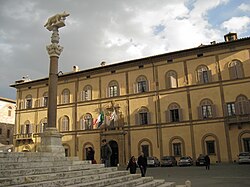Province of Siena
| Province of Siena | ||
|---|---|---|
| Province | ||

Palazzo Reale in Siena, the provincial seat.
|
||
|
||
 Map highlighting the location of the province of Siena in Italy |
||
| Country |
|
|
| Region | Tuscany | |
| Capital(s) | Siena | |
| Comuni | 36 | |
| Government | ||
| • President | Fabrizio Nepi (PD) | |
| Area | ||
| • Total | 3,821 km2 (1,475 sq mi) | |
| Population (31 May 2009) | ||
| • Total | 270,333 | |
| • Density | 71/km2 (180/sq mi) | |
| Time zone | CET (UTC+1) | |
| • Summer (DST) | CEST (UTC+2) | |
| Postal code | 53010-53015, 53017-53025, 53027, 53030-53031, 53034-53037, 53040-53043, 53045, 53047-53049, 53100 |
|
| Telephone prefix | 0577, 0578 | |
| Vehicle registration | SI | |
| ISTAT | 052 | |
The Province of Siena (Italian: Provincia di Siena) is a province in the Tuscany region of Italy. Its capital is the city of Siena.
The province is divided into seven historical areas:
The area is a hilly one: in the north is Colline del Chianti; Monte Amiata is the highest point at 1,738 metres (5,702 ft); and in the south is Monte Cetona. To the west are the Colline Metallifere (“Metallic Hills”), whilst the Val di Chiana lies to east.
Historically, the province corresponds to the former Republic of Siena.
The chief occupations are agricultural (wheat, grapes and fruit) and silk culture. The wine known as Chianti is produced here as well as in other parts of Tuscany: the Chianti Colli Senesi, however, is limited to this province.
Apart from the city of Siena the principal towns are Poggibonsi, Colle di Val d'Elsa, Montepulciano, Chiusi, and San Gimignano.
There are 36 comuni (singular: comune) in the province [1].
The main comuni by population, As of 2015[update], are:
This is the complete list of comuni in the province of Siena:
This is the complete list of the frazioni (singular: frazione) – towns and villages – in the province of Siena:
...
Wikipedia

